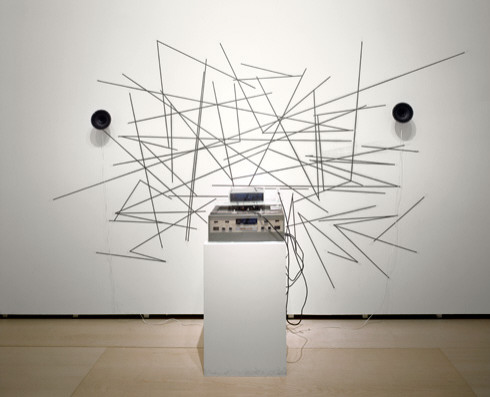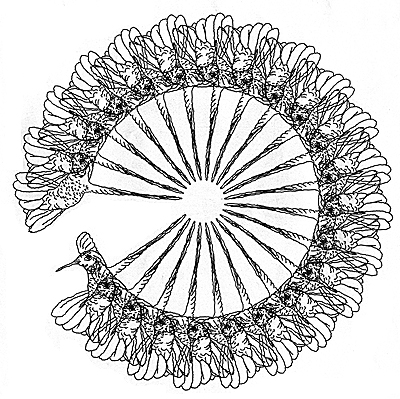Nam June Paik – Random Access, 1963
http://www.guggenheim.org/new-york/collections/collection-online/artwork/9536
http://www.medienkunstnetz.de/works/random-access/images/3/
Exploration of the Digital Mark – The 1960s
My artist research this semester has formed a unique hypertext landscape of its own.
I’ve been bouncing from Cubists to emerging new media, video artists to conceptual masterminds, paying special attention to weavers of divergent approaches, challenging spatial perspective and narrative through content. If they crush time, penetrate space, appropriate visual culture or otherwise shake that crazy old-and-new-media snow globe, I’m tracking them down.
As a result, I’ve been thoroughly enjoying Christiane Paul’s Digital Art, a survey of new media method, methodology and artists within (and through) varied technologies. There are several books in this series and Internet Art is next on my list.
I was already familiar with many of the referenced featured artists, thanks to electronic arts classes I’d taken at UNM, as well as independent research, but Digital Art does an excellent job contextualizing the work and presenting additional artists I was eager to learn about–especially in the proto-digital and early digital fields.
Since the Cascade has the ability to occupy a liminal space between object and non-object, digital and traditional, I found the digital pioneers of the 60s quite relevant.
Artists like Charles Csuri, Vera Molnar and John Whitney were engaging with the method AND methodology of new media, investigating the capacity of programming (and physical hardware), while maintaining an embrace of the aesthetic unique to computer art. In Visual Digital Culture: Surface Play and Spectacle in New Media Genres, Andrew Darley also traces the development of visual conceptual art through electronic channels, noting that over time, the commercial (and even, to some extent, the fine art impulse) of digital output became obsessed with mimicry and illusionism, such that the average viewer values highly polished, ultra real digital environments over work that engages the rawness of digital material in its own right. The earliest computer artists experimented with the mathematical and almost minimal nature of the digital mark without enslaving those marks to precision imitation of painting or photography. Of course they did not possess the appropriate tools to create 3D, rendered reality, and their marks are definitely influenced by painterly traditions, but experimentation with the computer as both tool and medium was of primary importance. Marks were allowed to be themselves, referencing painting, diagrams, maps and even sculpture–yet still inherently their own thing.
I won’t go over all of the artists and projects from the 1960s–but I am sharing a few here that piqued my interest . Nam June Paik heads this article with Random Access, a proto-digital project that allowed users to use a hand-held device to read strips of magnetic tape pasted to the wall (those lines are reel-to-reel sound bits). While he chose the sound snippets, they are positioned chaotically and the user can listen to each audio moment in whatever order they choose. Diligent audience-activators can also create their own compositions from the fragments! Random Access calls to mind other proto-digital projects like Nagy’s kinetic sculptures and Cage’s remixed, found sound. This kind of work is inherently digital, steeped in technology and the natural participatory nature of later computer art. Because of this, I’ll be revisiting Paik’s work this semester.
A. Michael Noll – Gaussian Quadratic (1962-5)
http://digitalartmuseum.org/noll/artworks.htm
http://dam.org/artists/phase-one/a-michael-noll/artworks
Though technically not a visual artist, Michael Noll was a key investigator of digital visual production and works like Gaussian Quadratic engaged the potential intellectual (and artistic) diversity of the computer-art medium.
The still above is actually part of an animation of moving geometric relationships. I was struck by its aesthetic connection to Paik’s work, though Noll experimented with a number of different output formats. He put the possibility of computer animation on the map and his work is part of the MOMA and DAM collections.
He worked at Bell Laboratories during his investigatory stage–like Claude Shannon, inventor of information theory. The Bell Labs produced a lot of hybrid science-art collaborations!
John Whitney – Catalog (1961)
John Whitney – Permutations (1966)
John Whitney, like Noll, works beyond the visual arts as a scientist, inventor, commercial animator and programmer and he’s considered one of the pioneers of digital animation. The opening sequence of Alfred Hitchcock’s Vertigo? That’s him.
Catalog (1961) was intended to showcase the variety of transitional processes possible in computer animation, behaving as both archive and performance. The nature of this piece, like other digital work from the 60s, embraces the unique aesthetic of digital in its own right, developing a sense of movement, information space and virtuality that extends our understanding of data relationships. Catalog is essentially visual math, with transformations made possible by the fluid, dynamic nature of binary code.
I can’t help but find aesthetic and investigatory parallels to Marcel Duchamp‘s Anemic Cinema (1926):
Best of all, Whitney’s animation computer was built int he 1950s, reclaimed from a WWII anti-aircraft gun detector. The 12-foot machine only produced black and white imaging and color was added using filmic processes later.
Csuri – Hummingbird (67)
Charles Csuri – Sinescape (67)
Charles Csuri was also influential in the investigation of computer-generated visual transformations. In this case, his plotter drawings reference the hand, while acknowledging the characteristics of digital repetition and malleability. Sinescape almost defies classification, behaving as both a Chinese ink painting and as an oddly mutated mathematical space, which prevents the viewer from nailing down an understandable horizon.
This ambiguous distinction of mark fascinates me and I found the Csuri Project (above) worth hours of investigation.
Hummingbird behaves as an unfinished mandala, transforming a familiar wire frame illustration into a tight, patterned expression of movement and unity. The hummingbird loses its individuality–even its identification, in multiplicity, becoming an entirely new unit of visual information. There’s an added bonus here that relates to my work, which is not evident in the image above. Csuri then screenprinted Hummingbird onto Plexiglas. From digital to printmaking… that’s my kinda guy.
Vera Molnar – No title, 1968, plotter drawing.
Vera Molnar – Interruptions, 1968/69, open series, plotter drawing, 28.5 x 28.5 cm.
Vera Molnar – 9 Gelbe Quadrate – 9 Carrés Jaunes, Öl auf Leinwand, 41 x 41 cm , 1968.
http://dam.org/artists/phase-one/vera-molnar
http://www.veramolnar.com/
http://www.atariarchives.org/artist/sec11.php
Vera Molnar, like Csuri, also worked with plotter drawings in the 1960s, investigating the unlimited potential for building, mutating, changing and outputting patterns and shapes. She applies a painterly sense of consciousness to the seemingly sterile personality of electronic production, marrying divergent mediums through concept and formal approach.
She says of her work, “I develop a picture by means of a series of small probing steps, altering the dimensions, the proportions and number of elements, their density and their form, one by one in a systematic way in order to guess what kind of formal modification challenges the change in the perception of my picture: perception being the basis of aesthetic reaction.” (from AtariArchives.org).
I’m attracted to her compositional and conceptual sensibilities–and the line present in her plotter drawings and Noll’s animations remind me of the lines I use in my artifact drawings. There is a relationship between the digital mark and the hand that I find present in her work (and the works of others shared here) that neither denies the inherent qualities of computerization, nor turns completely away from the traditional.
I’ll be sharing more contemporary digital and new media artists I’m researching soon!
Here are more plotter drawings from the 1960s, including some of Vera’s: http://dam.org/exhibitions/plotter-drawings-from-1960s
Additional Resources: http://digitalartmuseum.org/






